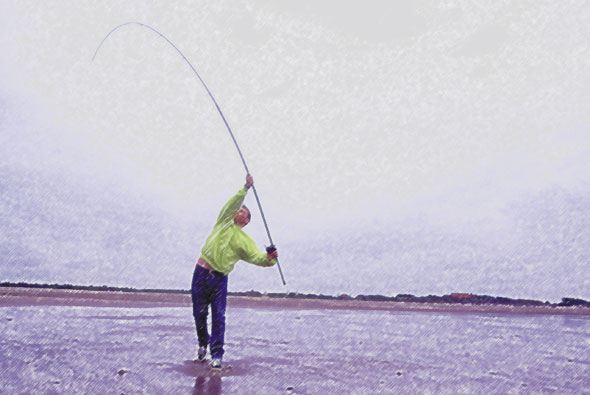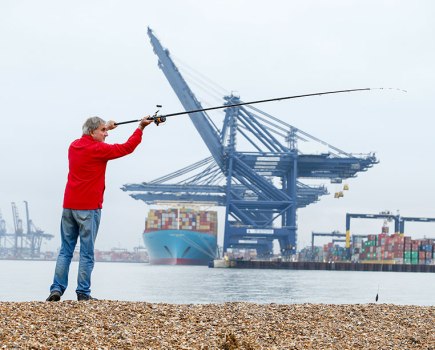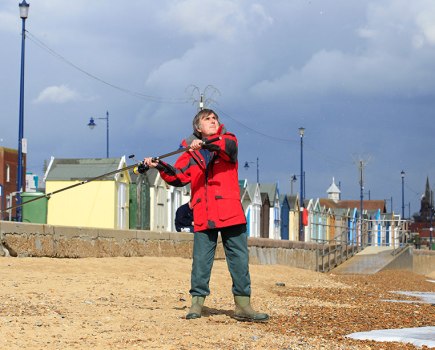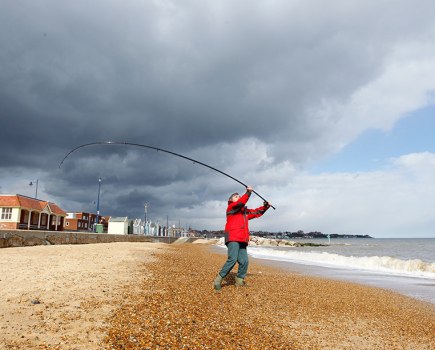Confused and frustrated with beach fishing? Caught in the trap of trying to fish with rods you can’t bend? Getting little enjoyment from a sport that can offer you leisure, pleasure, fun and excitement? Then follow this brand new series as John Holden slices through the bullshit and explains how to get the best from British beach fishing by being able to cast to reach the fish
 Who is John Holden?
Who is John Holden?
John Holden was a leading light on the UKSF casting circuit in the late 70s and early 80s. A great friend of Terry Carroll of Zziplex fame, he was one of just a handful of beach anglers who actually understood beach casting in relation to real fishing. John helped launch our highly successful Casting Instructor scheme and went on to write his highly acclaimed books Long Distance Casting and Beach Fishing.
This new series aims to strip casting to the bare bones, throw away the bits that no longer relate to beach fishing in the 21st Century, then rebuild what’s left into a simple, but power-packed, system of achieving all the distance you will ever need to catch fish.
For newcomers and inexperienced anglers confused by tackle, tuning and casting styles, I’ll present step-by-step methods that not only get the job done but also form a rock solid foundation for more advanced casting.
For the person who already casts a long way, there will be plenty of information and tactics to squeeze out those vital extra yards on the beach and in the practice field.
I shall also be rocking the boat, for it’s my intention to wreck some of the misconceptions about casting and tackle design. That we’ve been doing things more or less the same way for the past 30 years doesn’t mean there is nothing more to learn. Mistakes were made along the way, for which we are now beginning to pay a heavy price.
Despite the excellence of today’s tackle and the mind-blowing tournament results, is the angler on the beach well served by tackle designers? On average you are so limited in casting power as to stand not a hope in hell of consistently delivering bait much beyond the 100 yard mark.
Exactly what can a 13ft long range match outfit do for you? Is pendulum style the only way to go, or should he choose a less demanding method, more in keeping with the time he can spare for practice?
By kitting yourself out with a rod that he can bend and a reel that behaves itself, and re-focusing on what actually counts in the mechanics of hurling a rig out to sea, you’d soon have 20, 30, 50 extra yards on tap.
Cost is not a deterrent: the lowliest beachcasters from back street China deliver 125-plus fishing with contemptuous ease almost regardless of style.
Good casting from the beach – obviously not by tournament standards – is straightforward and quick to learn once the key steps are clearly spelled out. A fat wallet is more likely to hinder you than to help.
Why can’t I cast?
I don’t claim to have a miracle formula for teaching people to cast a long way. After 30 years of running clinics and seminars all over the world involving getting on for 200,000 people, I have seen most of the problems. Actually, there are very few.
The question always thrown at me, whether in English, Spanish, Italian, Danish, French, Japanese or a dozen other languages, is always the same: “I have good gear, I’ve read the magazines and watched the videos, I practise regularly… so why can’t I cast?”
Reasons for casting poorly are simple and commonplace.
The ‘secret‘ of success? Basics. Adapt those into an individual casting style that works best for you. There is no THE in casting style: no THE pendulum, no THE South African, no THE anything else. Every caster differs in physique, timing, co-ordination and dedication; no two casters are ever identical even if they’re using the same principles.
Develop your personal variation of those themes, and if the basics are correct at least one of them will deliver everything you could wish for. Incidentally, it’s well worth bearing in mind that rebuilding a weak cast usually means forgetting unnecessary details.
Here is the list of major headings. We shall go through each topic in depth as the series progresses…
● Body ‘engine’ is lacking
● Wrong method for the individual
● Over-gunned rod and over-tuned reel
● Preoccupation with reaching a certain distance
● Fear of letting fly
● Paralysed by irrelevant information
Where have the fishing rods gone?
I am lucky to have the experience to adapt to almost any length, action and stiffness of blank. But if you present me with an armful of assorted beach rods – such as you might find in any reasonable tackle shop – the odds are that half are so vicious and stiff that my fishing would be ruined.
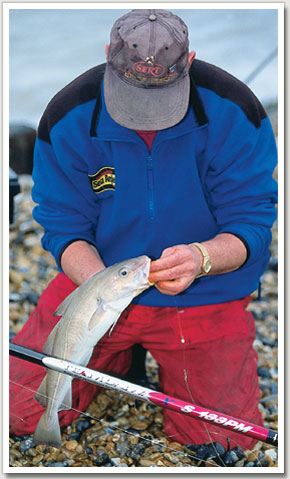 A few are so over-the-top that I can’t cast them. Most of the rest are on the well hard side of muscular – usable, but lacking in finesse. Maybe three out of 20 models have what I’m looking for; increasingly, they are found at the lower end of a manufacturer’s range.
A few are so over-the-top that I can’t cast them. Most of the rest are on the well hard side of muscular – usable, but lacking in finesse. Maybe three out of 20 models have what I’m looking for; increasingly, they are found at the lower end of a manufacturer’s range.
I’m not saying that these modest beasts are the right choice for everyone. For one thing, I have never liked super-powerful rods for general fishing. One hundred and fifty yards with baits is usually more than ample. On the rare occasion when I do need greater yardage, out comes a tournament-grade pole – and to hell with its drawbacks. Nasty rod plus fish always beats nice kit and nothing.
I do not need a blank that starts coming on song the other side of 225 yards; I don’t want a rod that feels like a scaffold pole. I much prefer a fishing rod that peaks over grass at around 200 yards, feels distinctly soft at 225 yards, yet is sweet-acting all the way down to sub-100 yard fishing ranges.
When did you last read a review that mentioned a rod’s useful minimum distance? A blank’s overall power band is what counts on the beach, not its top end performance alone.
Why is it fast becoming difficult to track down a rod that blends all-round practicality and sweet handling with a stiffness/action nicely balanced to realistic fishing distances with 150g, my favourite weight for medium-heavy work? Why do the manufacturers assume that I want to use a big pendulum cast and a long drop?
It is far more sensible to deliberately limit a non-specialist beach rod’s maximum range in order to build in user-friendliness and angling versatility. To design rods for general sale on the basis that distance is the only factor worth considering merely underlines a lack of imagination and, worse, remoteness from the real world of angling.
The risks of being over-gunned in the rod department are much more critical for beginners and those less-able casters who have yet to develop the timing and power to master anything more than a bread-and-butter beach stick.
Isn’t it plain daft to produce mass-market rods that actually block anyone’s chances of learning to cast properly? The vital question is not how many anglers benefit from powerful rods. It is how many newcomers does beach fishing lose because they were sold such inappropriate gear that they soon gave up in frustration.
It would be more rewarding for us lesser mortals to choose from a much wider selection of rods, none of them brutally over-gunned. Some all-rounders, others geared to options of casting style, sinker weight, type of reel, species of fish, nature of beach and other practical criteria?
‘Bad’ casting can come good
There are interesting choices to be considered for casting technique alone. Pendulum isn’t the only serious style, nor is it always the best. For many anglers with limited opportunity and no enthusiasm for serious practice, it is truly the casting style from hell. Only a tiny minority would suffer if aerialised casts suddenly disappeared.
Off-ground and other non-swing methods excel on almost any beach, offering effortless, impressive distances with minimal bait damage. This is not a criticism of pendulum casting, which in the right hands and at the right time is the supreme method of blasting a sinker out of sight. But an all-rounder it ain’t, other than in the shortened fishing version.
The latest materials can be fashioned into rods that were impossible to make even 10 years ago. Rods, for example, that deliver excellent on-beach distances using ‘wrong’ casting styles such as a left-hand dominant swipe. With suitable gear plus a bit of reel re-tuning, this and other methods written off 20 years ago as disastrously awful are worth a second look, especially if you lack the time to practise or cannot be bothered.
Such rods are not available because there is currently no demand. There will be no demand until anglers realise that such options do exist.
The argument for change broadens to include the wider world of beach fishing.
It is no longer realistic to suppose that today’s objectives are the same as they were when the current chapter of sea angling began some 30 years or so ago.
That being the case, a re-examination of tackle and tactics is inevitable if we are to make the best of what fishing remains around our coastline. Innovation will also inject a great dose of fresh interest and pleasure into the sport. Time to wake up and see what we’re missing.
How we got here and what we forgot along the way
Modern beach fishing is rooted in the late 1960s when the cod boom and its demand for long-range casting destroyed the old ways of thinking. New tackle and radically different ideas drove a 6oz sinker and a hookful of lugworms way beyond the dreams of old timers who dibbled their baits a little way out from the water’s edge.
The personalities, the methods and the products that powered the sea fishing revolution are well documented and lead directly to the modern tournament and beach scene. It’s a logical progression of technology and technique keyed exactly to catching fish, you might think. Half right. We’ll be looking at another aspect of the story in the next feature.

